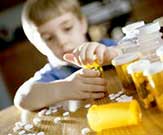|
|
 |
|
The views expressed on this page are soley
those of the author and do not
necessarily represent the views of County
News Online
|
 |
Start Talking!
Know! To
Secure, Monitor and Properly Dispose
3/26/2018
Families are continuing to be devastated by children abusing medicine.
Kids end up in the ER, become addicted, suffer physical pain and
emotional turmoil, and some lose their lives altogether - all in the
name of prescription drug abuse. Medicine abuse among youth continues
to trend at an alarming rate. Why is this occurring at such rapid
levels? According to youth, they use to get high, treat pain, sleep,
stay awake, fit in or do better in school. The majority of youth say
they can get these drugs easily and for free, from unknowing,
unsuspecting family members and friends through unlocked medicine
cabinets.
The most commonly abused prescription drugs fall into three categories:
painkillers, depressants and stimulants. Because so much attention,
nationwide, has been drawn to the dangers of prescription pain pills
(and rightfully so), many people are now aware of the hazards they
present and are hopefully more vigilant in keeping them properly stored
and monitored. However, many people are not aware of the risks from
other prescription and over-the-counter drugs, and how common these
medications are abused.
Doctor-prescribed stimulant medications used to treat anxiety, for
instance, are common drugs of abuse, as well as doctor-prescribed
depressants, like sleep medications. Young people typically abuse
stimulants to stay awake or get ramped up for a night of partying,
while depressants may be later used to come back down, relax or to
induce sleep.
Some teens are known to grab pills from home, or from the homes of
relatives and friends, not knowing what the pills are or what they do.
Teens also attend “Skittles” parties, where everyone brings pills to
dump in a bowl, and then pop them in their mouths like candy. In this
situation, users have no idea what they’re ingesting or the side
effects that might accompany any one particular pill, let alone the
outcome of mixing with alcohol or other drugs.
Then there’s cough medicine; the sticky, syrupy stuff that most
children turn their nose up to when they’re actually sick because of
the bitter taste. Both the prescription strength syrup that contains
codeine, as well as the over-the-counter version that contains DXM, are
both being abused by teens. Mixed typically with Sprite (or other soda)
and a Jolly Rancher, this nasty-tasting medicine, often referred to as
Purple Drank, Syrup, Sizzurp and Lean (because it literally causes
users to lean over), becomes a candy-flavored cocktail that produces a
relaxed, euphoric high, when taken in high doses.
ADHD medicines are also popular drugs of abuse among youth, frequently
being abused for purposes of weight loss or academic performance
enhancement. As youth get older, parents are more likely to entrust
them to handle and self-administer their own medications. But far too
often, these pills end up in the hands of unintended users, like
friends or classmates.
The side-effects and drug interactions of these medicines can be highly
dangerous, and even deadly. It is immensely important for parents,
grandparents and other adults to eliminate the ease of access of these
drugs by removing medications from nightstands, kitchen cabinets and
any other unsecured location, and to then follow these three simple
steps:
SECURE: Safeguard all your prescription and over-the-counter
medications in a locked cabinet, drawer or safe that is inaccessible to
your teens and their friends.
MONITOR: Make note of how many pills or the amount of liquid in each
medicine bottle you have in your home. Keep track of refills and be
sure you control any medication that is prescribed to your child.
DISPOSE: Take advantage of the many drug drop boxes and drug take-back
days that are available across the country. Otherwise, follow these
guidelines for proper drug disposal of unused, unwanted and expired
medications.
Click here to find a drug drop box in your area.
Learn how to get the drug prevention conversation started at
StartTalking.Ohio.Gov.
|
|
|
|

